The Library of Spanking Fiction: Wellred Weekly
|
||||||
|
Articles
Items of interest regarding all things spanking
|
||||||
|
|
Bunter 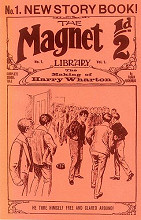 If one is looking for vanilla works of fiction that feature no shortage of corporal punishment then one need look no further than the series of comics and books that feature the character of Billy Bunter, a fictional pupil at Greyfriars School. The character was created by Charles Hamilton, or Charles Harold St. John Hamilton to give him his full title, using the pen name Frank Richards. In the vast majority of Billy Bunter stories one is likely to find at least one caning, usually carried out by the pompous, gimlet-eyed form-master, Mr Quelch. If one is looking for vanilla works of fiction that feature no shortage of corporal punishment then one need look no further than the series of comics and books that feature the character of Billy Bunter, a fictional pupil at Greyfriars School. The character was created by Charles Hamilton, or Charles Harold St. John Hamilton to give him his full title, using the pen name Frank Richards. In the vast majority of Billy Bunter stories one is likely to find at least one caning, usually carried out by the pompous, gimlet-eyed form-master, Mr Quelch.Charles Hamilton had originally created the character along with a series of sketches in 1899 but his work wasn't accepted and remained unpublished. Several years later, however, Bunter was resurrected when in 1908 the editor of The Magnet, a new weekly boys' story paper published by Amalgamated Press, invited 'Frank Richards' to write for them. The very first issue was published on February 15th, 1908 and was to continue being produced until 18th May 1940 by which time no fewer than 1,683 issues had been published. Of those it was believed that Hamilton wrote around 1,380 of them with the remainder being completed by 'fill in' writers. It appears that the main reason for The Magnet ceasing publication was a shortage of paper that occurred during the Second World War. 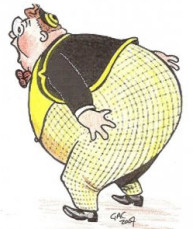 In 1946 the publisher, Charles Skilton, read an article entitled 'Do you remember Billy Bunter?' which was featured in the Picture Post and he subsequently contacted Hamilton, who was then 70 years old, to propose that he continue the Bunter stories in hardback book format. He agreed and proposed his usual fee of 30 shillings per thousand words but Skilton suggested royalties instead which worked out very well for Hamilton who went on to receive £1,000 rather than the £90 he would have accrued. The first book, Billy Bunter of Greyfriars School, was released in September 1947 and Skilton went on to publish a further nine before selling the rights to Cassell who published another 29. In 1946 the publisher, Charles Skilton, read an article entitled 'Do you remember Billy Bunter?' which was featured in the Picture Post and he subsequently contacted Hamilton, who was then 70 years old, to propose that he continue the Bunter stories in hardback book format. He agreed and proposed his usual fee of 30 shillings per thousand words but Skilton suggested royalties instead which worked out very well for Hamilton who went on to receive £1,000 rather than the £90 he would have accrued. The first book, Billy Bunter of Greyfriars School, was released in September 1947 and Skilton went on to publish a further nine before selling the rights to Cassell who published another 29.What then of the actual character of Bunter himself and his surroundings? According to Hamilton, the inspiration for Bunter was derived from three actual people: a corpulent editor, a short-sighted relative and a second relative who was forever trying to secure a loan on the basis of the anticipated receipt of a cheque. 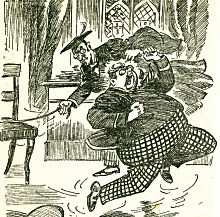 Initially, Bunter was not a major figure within the Greyfriars stories of The Magnet but it was not long before Hamilton realised the comic potential of the character and he soon became the focal point of many of the stories. Initially, Bunter was not a major figure within the Greyfriars stories of The Magnet but it was not long before Hamilton realised the comic potential of the character and he soon became the focal point of many of the stories.Weighing in at around 14 stones Bunter's main physical characteristic is one of obesity, brought about specifically by over-eating. He is also distinguished by short-sightedness and wears round glasses, his short-sighted squint and weight resulting in his frequent description as 'the fat owl of the Remove', the 'Remove' being the name given to the Lower Fourth form at Greyfriars. In terms of his personality, one would have to describe him as something of an anti-hero, having been referred to as "dishonest, greedy, pathologically self-centered, snobbish, conceited, lazy, cowardly, mean-spirited and stupid"! Despite his negative attributes he nevertheless manages to appeal to the reader by virtue of the humour he generates and due to the fact that his various schemes never succeed and inevitably result in punishment. 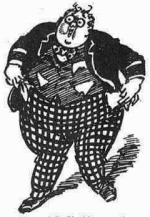 At school the majority of his time is taken up with devising means of pilfering food in order to support his insatiable appetite and he shows little, if any, interest in anything else, including classwork and sports. When not actively engaged in some scheme to acquire food he is more than likely to be trying to raise a loan on the basis of a postal order that he is perpetually expecting but which never turns up. At school the majority of his time is taken up with devising means of pilfering food in order to support his insatiable appetite and he shows little, if any, interest in anything else, including classwork and sports. When not actively engaged in some scheme to acquire food he is more than likely to be trying to raise a loan on the basis of a postal order that he is perpetually expecting but which never turns up.His speech is notable for a series of frequently repeated catchphrases. These include his invariable opening line, "I say you fellows"; his reply to criticism, "Oh really Wharton" (or whoever is speaking); his characteristic giggle, "He, he, he"; and his exclamation of pain, "Yarooh" (which is "hooray" spelled backwards). In 1940, in an essay entitled Boys' Weeklies, George Orwell described him as... ...a real creation. His tight trousers against which boots and canes are constantly thudding, his astuteness in search of food, his postal order which never turns up, have made him famous wherever the Union Jack waves. Going on to say... Billy Bunter, for instance, must be one of the best-known figures in English fiction; for the mere number of people who know him he ranks with Sexton Blake, Tarzan, Sherlock Holmes and a handful of characters in Dickens. The books were initially illustrated by R.J. Macdonald who had been one of the most prominent illustrators of the old Gem, a story paper for which Hamilton had also written stories. Following his death in 1954 the art work was carried out by C.H. Chapman, who had originally worked on 'Magnet' and had been the first to depict Bunter in his check trousers. 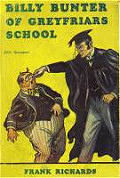 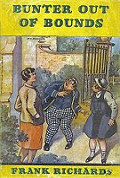 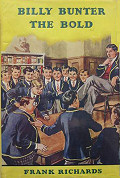 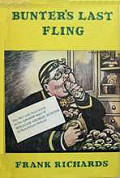 An example of a typical Bunter yarn can be found in the 28th book in the series of hard backs, Bunter Out Of Bounds. Here, a fellow pupil has knocked over the form master, Mr Quelch, but has managed to escape without being recognised in the fading light. Bunter foolishly boasts that he was responsible which then comes to the attention of Quelch. He is then sentenced to be flogged in front of the entire school: Mr. Quelch opened the door with one hand, and propelled Bunter outside with the other. In the corridor, he released the fat Owl. At this point Bunter makes his escape, remains out of bounds for a number of days, returning only when the real culprit has been forced to own up. Unfortunately, he is then overheard saying he would up end Quelch soon as look at him and the inevitable ensues... "What did you say, Bunter?" Another example featuring Bunter on the receiving end can be found in Billy Bunter the Bold: "You have deliberately darkened your eye with soot, to give it the appearance of a black eye, and have ventured to play this insensate trick in the form-room - to play this trick on me! On ME! I shall cane you for this foolish prank. Hand me the cane from my desk, Bunter." 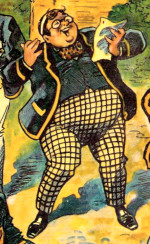 Bunter's creator, Charles Hamilton, died on Christmas Eve, 1961 by which time he appears to have penned at least 70 million words although there are higher estimates of 90 and 100 million words widely quoted. Based on word count he is commonly thought to be the world's most prolific author and as such has featured in the Guinness Book of Records. Bunter's creator, Charles Hamilton, died on Christmas Eve, 1961 by which time he appears to have penned at least 70 million words although there are higher estimates of 90 and 100 million words widely quoted. Based on word count he is commonly thought to be the world's most prolific author and as such has featured in the Guinness Book of Records.There is, however, some doubt in regards to whether Hamilton wrote all the stories that are attributed to him. At the time of Hamilton's death, the initial publisher of his hard back series, Charles Skilton, wrote a letter which suggested that there were only two more books yet to be released but the publishers, Cassells, went on to publish another seven. The 38th and final Bunter book in the Cassells series appeared in 1965, four years after the author's death. It was originally to have been entitled Bunter to the Rescue, but being the last of the series it was eventually re-titled Bunter's Last Fling with the agreement of Mrs. Una Wright, Hamilton's niece and literary executor. Those closely familiar with Hamilton's work appear adamant it was not written by him claiming that the whole appearance of the prose is different and some have further suggested that it is in fact the work of his niece. Whoever the actual author of this last Bunter publication actually was, it is encouraging to see that it was very much business as usual: "You may go, Vernon-Smith. Bunter!" 16 comments:
islandcarol said...
Nice job on your research, Februs; Billy Bunter was quite the buffoon it seems. It is amazing the quirky characters the public find popular. We were all impressed when graphic novels became the hot thing in publishing not too many years ago and truly, there is little new under the sun. 22 July 2012 22:16
bendover said...
Great job, Februs. I agree that Billy was truly the court jester at Greyfriars. Hamilton created a fictional account of corporal punishments, that closely resembled the Tijuana Bibles of that era, involving sexual accounts of well know cartoon characters. Well done. Your research on these articles is to be commended, Febs. Always very informative. 22 July 2012 22:57
Lincoln said...
A nice trip down memory lane as Billy Bunter was required reading (not by the teachers!) at my boarding school as we could identify ourselves with the setting. It wasn't all about Mr Quelch and his cane! There were some non-spanking novels involving the fat owl. 23 July 2012 15:00
barretthunter said...
I just about remember him being famous, though his milieu was very different from mine. One thing that struck me looking at this article was a small piece of plaster from the roof...sorry, I'll try again...was how well drawn the opening orangey comic cover was, with the two boys on the left, in particular, in a very realistic slightly slouching stance. 25 July 2012 19:52
njrick said...
Thanks for an introduction to a body of spanking literature I never knew existed. 26 July 2012 03:09
Malahide said...
Delightful to recall Bunter's episodes at Greyfriars - I recall the characters - Bob Cherry et al. 26 July 2012 20:17
mati said...
The popularity of "Anti-Heroes" like Billy Bunter, but also Dennis the Menace seems to be a very British phenomenon. The most English children's books are well known over here, but I don't think anybody ever bothered to translate Billy Bunter. That makes your article all the more interesting. 28 July 2012 09:49
Lincoln said...
I've just remembered that there was also a "Bessie Bunter" as well, presumably written for the schoolgirls' market by Frank Richards. Does anybody remember her, and did her capacious behind receive the same treatment as her fat brother? Perhaps some of my fellow oldies might remember. 28 July 2012 11:19
Februs said...
@Lincoln Bessie was basically a female version of Billy, being obese, obnoxious and with a huge appetite. She was a pupil at Cliff House School, a girls school not far from Greyfriars. In Out of Bounds Billy at one point goes to visit her hoping she will help him but of course she's not interested and he ends up getting nabbed by the formidable games mistress, Miss Bullivant :) 28 July 2012 12:41
PhilK said...
Bunter also appeared on television, in a BBC TV series that ran from 1952 to 1961, and got caned in virtually every episode. He was played throughout by the actor Gerald Campion, who was 31 when the series began and 40 when the final episode screened. By this stage, his impersonation of an adolescent boy was becoming a bit creepy. 29 July 2012 22:53
Lincoln said...
@PhilK And also Mr Quelch was played by that fine actor Kynaston Reeves, (who also was in the first and best Forsyte Saga). There was a second Mr Quelch who was not nearly as convincing, but I can't remember his name. 30 July 2012 17:52
mobile_carrot said...
Great article there Febs! I remember my delight when I lived in Leeds in the 1980s at finding facsimile copies of all the Bunter novels (complete with original adverts) in the Central Library. For some reason I always preferred the Greyfriars ones with the predictable whacking to the rather unlikely stories of Bunter and the Famous Five ending up in Brazil or South Africa in the school holidays.. 30 July 2012 18:27
blimp said...
Lincoln- Bessie Bunter never received a whacking at Cliff house! Or at least not in the one book published by Charles Skilton and written by "Hilda" Richards. Bessie also appeared in the Schoolgirls Own Library and The School Friend storypaper, apparently Frank Richards(Charles Hamilton) wrote the first half dozen School Friends then various substitute writers took over. Very few spankings in girls school stories sadly. Only Nancy Moss and J.Radford Evans spring to mind! This is a shame because the occasional spanking would greatly improve the likes of Angela Brazil and Elinor Brent Dyer. However Miss Bullivant, the PE mistress at Cliff House, deals out several spankings to boys (never girls)in the Magnet's long saga. Victims include Ponsonby and the Fat Owl himself! 22 October 2012 00:49
Ernest said...
I enjoyed the Billy Bunter books at a number of levels. They were entertaining and funny, as well as having the possibility that - eventually - 'lines' would be replaced on Mr Quelch's agenda by 'whops'! In fact I enjoyed all school stories, at a certain age - even though the CP element was much less frequently found in some than in others. I even read girls' school stories, and - within my own imagination - changed the strange games they played like hockey and tennis into something more interesting like football! Of course, the punishments needed even more readers' license to make them interesting! Did others do that, I wonder? 13 September 2013 20:12
Steve0958 said...
I have loved reading the Greyfriars stories since I was about 9 years old. I started reading the Cassell reprints – the yellow covered ones illustrated in Februs’ article – borrowing them from the local children’s library. I still remember the feeling of shock that I felt when I saw Bunter’s Last Fling on the shelves of W H Smiths. There was a black border on the cover and a notice on the blurb on the back that the author had died. I didn’t know at the time that what I had been reading were mostly reprints of what had appeared in the “Magnet” story papers over the period from 1908 to 1940. There was not much in them that appeared completely out of date – we still had pounds, shillings and pence, the cane was still used in most schools, our house still had its open coal fire, postal orders were around as were ten shilling and pound notes. Even top hats were not that uncommon – my own uncle wore one. The slang was unfamiliar, but you soon got used to it. It was clear enough what the Removites meant when they referred to Herbert Vernon-Smith as a “bounder” – though he is by no means a complete rotter like Skinner or Loder. One of the wonderful things about the stories is the number of quotations from classical sources and from the Bible with which the stories are peppered. I really enjoyed spotting these and they encouraged me to read widely. Sometimes I was completely baffled by the language. I remember puzzling for a long time over what “hors de combat” might mean, when a boy had lost a boxing match. “Hors” was not in my school French dictionary and when I saw “hors d'oeuvre” on a menu I struggled to think of a word that made sense in both contexts. It simply means “out”, of course. Smithy was out of the fight and hors d'oeuvres are out of, or not part of, a main meal. I started to read the Howard Baker facsimiles of the original story papers from the late 1960s and built up a large collection for these, which I still own. Nowadays, practically all of Charles Hamilton’s works (or oeuvre!) may be found online on the Friardale site http://www.friardale.co.uk/index.htm Reprints of the “Magnet” are on http://www.friardale.co.uk/Magnet/Magnet.htm and you can work through them year by year and issue by issue. The “best” period is a matter of considerable debate among fans, but he probably got better and better until the mid-twenties and stayed there until the end when the magazine folded because of war-time paper shortages. Incidentally, the stories were never exclusively read by children and during the First World War copies were sent to our soldiers in the trenches and some of their letters were printed in the “Magnet”. There is lots more to explore on the site – though even reading the “Magnets” will take some time, but I would also recommend a look at some of the “Gem” stories about St Jim’s which are just as good as the Greyfriars stories but don’t have a stand out character like Bunter. “Gem” issues can be found on http://www.friardale.co.uk/Gem/Gem.htm The “Gem” started a year before the “Magnet” and ended at the same time. Both were weekly periodicals. There were 1,663 issues of the “Gem” and 1,683 of the “Magnet”. The vast majority of these included at least one story by Charles Hamilton (writing as Martin Clifford in the Gem). Orwell. In the article mentioned by Februs, declared that the style must be an easy one to copy as it was obvious that no one man could have written so many stories. Hamilton replied, explaining that the vast majority were by himself, and Orwell apologised. Some stories, though, were by substitute writers and then the change in style can clearly be seen. The “Gem” used substitutes more often than the “Magnet” – and at one point was forced to reprint old but genuine stories – and this is why the “Magnet” is a better place to start than the “Gem”. Remarkably little change takes place over the thirty years during which the stories were written. One change over the course of the stories is that in the earlier ones boys are caned on the hands but, from the 1920s onwards always on the bottom, over trousers. Charles Hamilton, although privately educated, did not attend a public school himself – Greyfriars is supposed to be on a par with Eton and Harrow – and it may be that it was pointed out to him that punishment at public schools would almost always be on the bottom. Originally, there was a German master at the school and, during WW1 he would repeatedly protest that he was a Saxon and not a Prussian, but he disappeared and the boys of the Remove only learned French with “Mosoo”, M Charpentier and, of course, Latin under the beady eye of Mr Quelch. The school uniform also changed slightly, though this may have been as much due to illustrators as to Hamilton. The heroes of the stories are the 14 and 15 year old boys in the Remove. Remarkably, Greyfriars has three fourth forms – the Remove, the Forth and the Shell. These are very competitive with one another. In the very early stories boys in the Remove can be made to “fag” or do chores for sixth formers, this changes very early on but their release from this is often referred to as having been a great triumph. Although the series of stories continued for decades the same boys stayed in the same forms throughout – with the notable exception of the complete duffer Horace Coker, who after having been kept back for many years – he has a younger brother in the 6th form! – finally gets into the fifth form at the instigation of his Aunt Judy. Boys in the fifth form at Greyfriars are rarely caned but so egregious is Coker’s behaviour and stupidity that he manages to be caned quite often after moving up. The focus of the stories, so far as the boys go, is on the Famous Five – Harry Wharton, Frank Nugent, Bob Cherry, Huree Ramset Jam Singh and Johnny Bull. Bull is the latecomer – they were originally the Famous Four. Hamilton coined the term Famous Five long before Enid Blyton! They always stay in the Remove with Quelch as their form master. Summer holidays come round – very long ones where they might go to Brazil, the Wild West or the South Seas – but when they, finally, return to school, it’s back to the Remove. The same form masters also featured throughout, though they were occasionally temporally replaced due to illness etc by substitutes – who would almost inevitably turn out to be imposters. Dr Locke, the headmaster, was also a fixture. When he was unable to carry out his duties one of the form masters would step up – the pompous Prout or the acerbic Hacker – prompting rebellion. Some of the best series deal with barring outs, when the boys effectively go on strike. Dr Locke sometimes punishes boys with a “flogging”. They are hoisted onto the back of Gosling, the aged school porter, in front of the school assembled in Hall. It is never made clear exactly what the punishment entails, though it is clearly regarded as more severe than a caning. Illustrations show it as taking place over the boys’ trousers. Corporal punishment takes place as just one part of everyday school life. Canings do not take place in every issue. Teachers who are over severe – like Hacker – are contemned. Teachers who rarely use the cane, such as Lascelles – who teaches Maths and Games and returned after fighting in the first World War - are praised. Februs’ statement that “In the vast majority of Billy Bunter stories one is likely to find at least one caning, usually carried out by the pompous, gimlet-eyed form-master, Mr Quelch” is true if you only look at the school series and not the holiday ones. A “Billy Bunter story” could extend over eight to twelve issues so there was certainly never an average of a caning per issue. I would also take issue with Februs’ description of Henry Samuel Quelch. He was never pompous. He was, as Februs says, gimlet-eyed, and was often referred to as “a beast but a just beast”. His colleague, the form master of the fifth form, Paul Pontifex Prout, was pompous – hence his nickname “Old Pompey”. For the period I think that there is very little – apart from corporal punishment – that would be regarded as politically incorrect now. One of the most popular boys in the Remove is a Jew – Monty Newland – he is hard working and a good sportsman. When anti-semitism does raise its head, it is always revealed to have been wrong-headed. One of the Famous Five is an Indian and Huree Singh is often shown to be the most intelligent and observant of the group – as well as being the Remove’s star bowler and a good footballer. He does have an idiosyncratic manner of speech and I’m sure that today some would call that racist. I don’t see, myself, how it can be as Huree Singh is depicted as almost the ideal English teenager. Hamilton chooses comical names for the Chinese boy in the Remove and his younger brother – Wun Lung and Hop Hi. Wun Lung is also sometimes given the “oriental” trait of wiliness. I find this a little harder to excuse but, again, both Chinese lads are shown as being good at heart and plucky. When the chums of the Remove (plus Bunter who will always tag along, unwanted) go to the South Seas, Hamilton gives a fairly realistic picture of the Polynesian and Micronesian cultures, mostly without looking down on them. He shows the people as intelligent and well-meaning. Like Herodotus, whose work he certainly knew well, he sees that customs can differ without one set being necessarily better than the other. He doesn’t approve of cannibalism, but neither does he approve of the atrocities of both sides in the First World War. The nearest Hamilton gets to racism, I’m afraid, is in his Anti-Americanism. Fisher T Fish, the American boy in the Remove, is a nasty piece of work – he lends out money at exorbitant rates of interest and is always attempting to cheat his schoolfellows. Even Bunter knows better than to try to touch Fish for a loan. When the boys got to the cinema they always choose to watch a British and not an American film (though they do go to Hollywood once and Wingate, the school captain, stars in a movie). American made alarm clock never work. This anti-Americanism was, I think, rooted in the aftermath of the World War when the Americans were seen as war profiteers who had joined the war only after the hard fighting had already been done. Ahistorical, I know, but widely believed. And there are a few good Americans in the stories – notably the Rio Kid in a crossover when the chums visit a ranch purchased by Vernon-Smith’s dad. There is very little hint of romance or sex in the stories. It is intimated that Bob Cherry has a crush on Marjorie Hazeldene – the sister of one of a boy in the Remove – but this goes no further than the occasional blush. Bunter, in his usual idiotic manner, fancies himself as a “ladies’ man” but only make himself a figure of fun. Bullying, smoking and gambling are all heavily condemned. Ironically, Hamilton himself seems to have had a gambling addiction. My own style of school story writing (I write as Mike from London) has been very much influenced by that of Charles Hamilton. I have recently taken to inserting Hamiltonian allusions in my stories and I hope that some of them will be noticed. Finally, it is worth saying that the Wikipedia article on Charles Hamilton https://en.wikipedia.org/wiki/Charles_Hamilton_(writer)#Literary_output says this: “It has been estimated by researchers Lofts and Adley that Hamilton wrote around 100 million words or the equivalent of 1,200 average length novels, making him the most prolific author in history. He is known to have created over 100 schools as well as writing many non-school stories. More than 5,000 of his stories have been identified, of which 3,100 were reprinted.” The Guinness Book of Records used to list him as the writer with the most copious output. 13 March 2022 13:25
KatiePie said...
I’ve just come upon this fabulous and well researched article on the Bunter stories. I discovered them in my teens, when I had a rather older boyfriend who had kept his collection, and I devoured them with delight. Girls’ school stories, though fun, very much lacked any cp whereas Bunter thrilled my girlish, perverted heart. 24 May 2022 14:50
You need to sign in if you wish to make a comment   |
|||||
| Pages: 1 2 3 4 5 6 7 8 9 10 11 12 13 14 15 | ||||||


